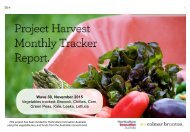potatoes
PA-DECJAN2016
PA-DECJAN2016
You also want an ePaper? Increase the reach of your titles
YUMPU automatically turns print PDFs into web optimized ePapers that Google loves.
26<br />
Ask the industry<br />
Reducing the risk of Pink rot<br />
infection this season<br />
with Scott Mathew<br />
DURING A RECENT VISIT TO TASMANIA, THE PROCESSING POTATO CAPITAL<br />
OF AUSTRALIA, SYNGENTA TECHNICAL SERVICES LEAD SCOTT MATHEW<br />
DISCUSSED THE CHALLENGES SURROUNDING THE USE OF IN-FURROW<br />
FUNGICIDES AND, IN PARTICULAR, PINK ROT MANAGEMENT.<br />
What are the conditions<br />
suitable for Pink rot<br />
development?<br />
Pink rot (Phytophthora<br />
erythroseptica) survives in the<br />
soil by producing oospores,<br />
which can survive for up to<br />
seven years. In the presence<br />
of <strong>potatoes</strong>, the oospores<br />
germinate to produce mycelia<br />
and sporangia. However, if the<br />
soil becomes wet, sporangia<br />
can germinate directly or<br />
release swimming spores called<br />
zoospores; these zoospores<br />
respond to chemicals released<br />
by the potato plant and swim<br />
toward potato roots.<br />
Pink rot can infect roots, stolons<br />
and underground stems of the<br />
plant. Once infected, the Pink<br />
rot pathogen can grow into the<br />
tuber, although initial infection<br />
occurs during the early stages of<br />
tuber development. The disease<br />
becomes most apparent during<br />
harvest (this is sometimes<br />
referred to as a latent infection).<br />
Later in the season, tubers can<br />
also become infected directly<br />
through eyes or lenticels during<br />
prolonged periods of high soil<br />
moisture.<br />
Pink rot develops rapidly<br />
at soil temperatures between<br />
10°C to 30°C; the optimal<br />
temperature for infection is<br />
25°C.<br />
Pink rot disease becomes<br />
most apparent during harvest.<br />
What are some of the<br />
management strategies<br />
I can put in place to<br />
reduce the risk of a Pink<br />
rot infection?<br />
No single control measure will<br />
provide effective control of Pink<br />
rot. The severity of Pink rot can<br />
be managed using an integrated<br />
approach that combines the use<br />
of host resistance, cultural and<br />
chemical control methods.<br />
Some key Pink rot control<br />
management strategies include:<br />
• Reduce the amount of<br />
inoculum in soil by removing<br />
crop debris. You can also cull<br />
volunteer <strong>potatoes</strong> from the<br />
field.<br />
• Control weed hosts. For<br />
example, controlling some<br />
nightshade species in nonpotato<br />
crop years will help<br />
reduce Pink rot carry over.<br />
• In irrigated potato<br />
production, water management<br />
is critical in areas where Pink<br />
rot is a threat. Overwatering<br />
can lead to increased Pink<br />
rot incidence; this may be<br />
especially true late in the<br />
season.<br />
• Avoid disease-favourable<br />
conditions at harvest. Tubers<br />
with immature skins are more<br />
susceptible to wounding during<br />
harvest operations, and wounded<br />
tubers are more susceptible to<br />
Pink rot infection.<br />
• Apply Metalaxyl-M at<br />
planting time, then follow up by<br />
applying Metalaxyl-M early in<br />
the growing period. Research<br />
has shown that this combination<br />
provides effective control of Pink<br />
rot.<br />
For the best protection against<br />
Pink rot infections, it is advised<br />
to follow a program of applying<br />
a Ridomil Gold 25G treatment at<br />
planting, followed by consecutive<br />
foliar applications of Ridomil<br />
Gold MZ at the four and six week<br />
interval after planting. Following<br />
this program offers potato<br />
growers the best protection<br />
against Pink rot infections.<br />
i<br />
For more information<br />
or to ask a question,<br />
please contact your<br />
local Syngenta Territory<br />
Manager, the Syngenta<br />
Advice Line on 1800 067<br />
108, visit www.syngenta.<br />
com.au or email Potatoes<br />
Australia: info@ausveg.<br />
com.au. Please note that<br />
your questions may be<br />
published.








